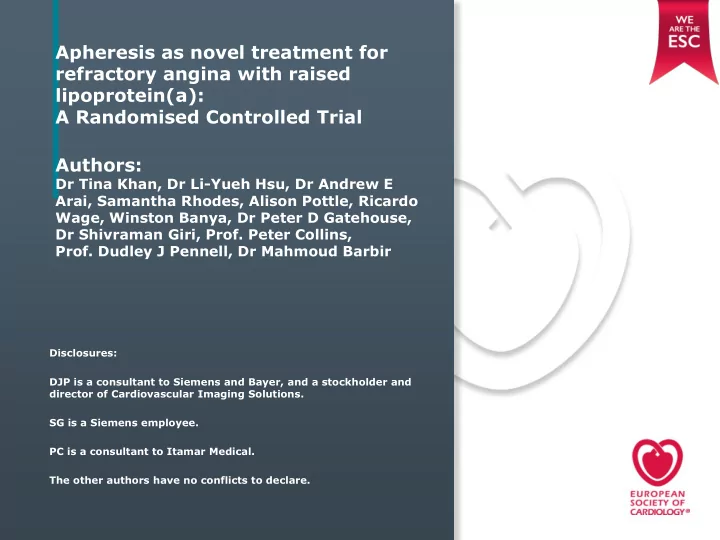

Apheresis as novel treatment for refractory angina with raised lipoprotein(a): A Randomised Controlled Trial Authors: Dr Tina Khan, Dr Li-Yueh Hsu, Dr Andrew E Arai, Samantha Rhodes, Alison Pottle, Ricardo Wage, Winston Banya, Dr Peter D Gatehouse, Dr Shivraman Giri, Prof. Peter Collins, Prof. Dudley J Pennell, Dr Mahmoud Barbir Disclosures: DJP is a consultant to Siemens and Bayer, and a stockholder and director of Cardiovascular Imaging Solutions. SG is a Siemens employee. PC is a consultant to Itamar Medical. The other authors have no conflicts to declare.
Speaker
Background Refractory Angina is challenging to manage and novel • therapeutic options are needed. Raised lipoprotein(a) [Lp(a)] is an independent • cardiovascular risk factor that can be effectively reduced by lipoprotein apheresis. Raised Lp(a) may be prevalent in Refractory Angina. • To date there is no randomised controlled data assessing • the clinical benefit of lipoprotein apheresis in patients with refractory angina and raised lipoprotein(a). Speaker
Declaration of Interest DJP is a consultant to Siemens and Bayer, and a stockholder • and director of Cardiovascular Imaging Solutions. SG is a Siemens employee. • PC is a consultant to Itamar Medical. • The other authors have no conflicts to declare. • Speaker
Purpose and key points about methods Purpose: To determine the effect of LA on quantitative myocardial • perfusion, carotid atheroma, exercise capacity, angina symptoms and quality of life (QoL) in patients with refractory angina and raised Lp(a) >500mg/L. Methods: An RCT with cross-over design in 20 patients with • refractory angina and Lp(a) > 500mg/L and LDL <4mmol/L, randomised to 3 months of blinded weekly lipoprotein apheresis or sham, followed by crossover. Primary endpoint: was change in quantitative myocardial • perfusion reserve (MPR) by cardiovascular magnetic resonance (CMR). Secondary endpoints: included measurement of carotid • atheroma burden by CMR, exercise capacity, angina symptoms and quality of life. Speaker
Results Primary endpoint: MPR increased by 0.47 [95% CI, 0.31 to • 0.63] from 1.45 ± 0.36 to 1.93 ± 0.45 following apheresis, but decreased during sham by -0.16 [95% CI, -0.33 to 0.02] from 1.63 ± 0.43 to 1.47 ± 0.30; yielding a net treatment increase of 0.63 [95% CI 0.37 to 0.89; p<0.001 between groups]. Secondary endpoints: Significant improvements in exercise • capacity, angina symptoms, quality of life and atheroma burden. Speaker
Conclusions In patients with refractory angina and raised Lp(a), • apheresis leads to statistically significant benefits in • myocardial perfusion, • carotid atheroma, • exercise capacity, • angina symptoms and • quality of life Speaker
Recommend
More recommend